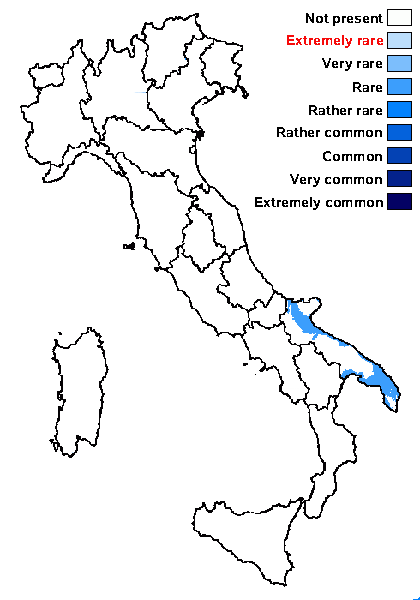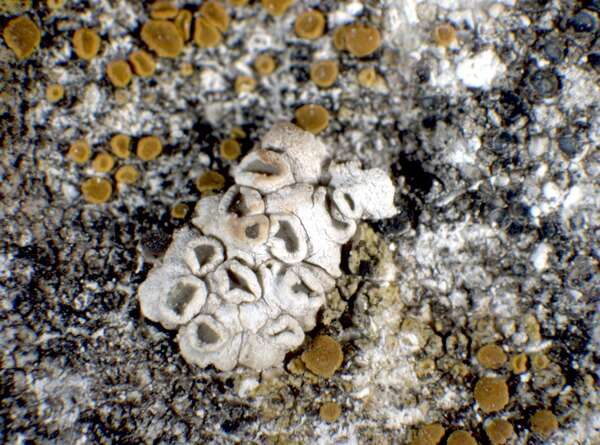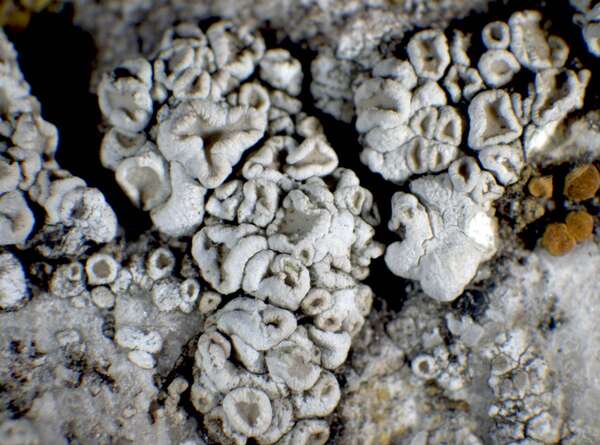Polyozosia congesta (Clauzade & Vězda) S.Y. Kondr., Lőkös & Farkas
in Kondratyuk & al., Acta Bot. Hung., 62, 1-2: 101, 2020. Basionym: Lecanora congesta Clauzade & Vězda - Portugaliae Acta Biol, B, 9: 331, 1969.
Synonyms:
Distribution: S - Pugl (Nimis & Tretiach 1999).
Description: Thallus crustose, episubstratic, whitish, rather thick, rimose-areolate, forming 0.5-1 cm wide patches. Areoles more or less convex, the peripheral ones often larger and indistinctly radiating. Apothecia lecanorine, 0.7-1.2 mm across, at first immersed, then sessile and strongly constricted at base, usually crowded and covering almost the whole thallus, with a flat, brownish grey, epruinose disc and a smooth, prominent, more or less wavy thalline margin. Thalline esciple corticate; epithecium brown, K- and N-, inspersed with small brownish crystals dissolving in K; hymenium colourless, 60-70 μm high; paraphyses simple or sparingly branched in upper part, 1.5-2 μm thick at mid-level, the apical cells slightly swollen; hypothecium colourless. Asci 8-spored, elongate-clavate, very thin-walled, with a K/I+ blue, tall tholus penetrated by a faintly amyloid apical cushion, the wall K/I-, surrounded by a K/I+ blue outer layer, Lecanora-type. Ascospores 1-celled, hyaline, ellipsoid, (9.5-)10-12 x 5-7 µm. Photobiont chlorococcoid. Spot tests: thallus and apothecial margin K- or K+ yellowish, C+ pink to red, KC+ pink to red, P-, UV-; apothecial disc K-, C-. Chemistry: thallus and apothecial margin with 2,7-dichlorolichexanthone plus gyrophoric and lecanoric acids, the latter two however absent from the apothecial disc. Note: a probably Mediterranean-Atlantic species found in the adlittoral belt in sites frequently hit by waves on inclined surfaces of calciferous rocks, probably more widespread along the Mediterranean coast. The species resembles P. bandolensis, but differs in the poorly developed, sublobate thallus reacting C+ red, the numerous, crowded, prominent apothecia covering almost the whole thallus, the thick thalline margin reacting C+ red and the pale grey-brown disc reacting C-, without the bandolensis-green pigment. Like P. poeltiana, it also contains 2,7-dichlorolichexanthone (thallus and apothecia), plus gyrophoric and lecanoric acids, the latter two however limited to the thalline margin of apothecia (see Bertrand & al. 2010).
Growth form: Crustose placodiomorph
Substrata: rocks
Photobiont: green algae other than Trentepohlia
Reproductive strategy: mainly sexual
Taxon bound to maritime-coastal situations
Commonnes-rarity: (info)
Alpine belt: absent
Subalpine belt: absent
Oromediterranean belt: absent
Montane belt: absent
Submediterranean belt: absent
Padanian area: absent
Humid submediterranean belt: absent
Humid mediterranean belt: absent
Dry mediterranean belt: rare

Predictive model
Herbarium samples


P.L. Nimis; Owner: Department of Life Sciences, University of Trieste
Herbarium: TSB (26216)
2001/11/25


P.L. Nimis; Owner: Department of Life Sciences, University of Trieste
Herbarium: TSB (26216)
2001/11/25

Modified from: https://gzu.jacq.org/GZU000289044
GZU000289044 - Collector Clauzade,G. Vězda, A.: Lichenes Selecti Exsiccati 779
Date 1968-06
Location France / Provence-Alpes-Côte d'Azur
Label Gallia - Bouches-du-Rhône: Marseille, insula Maire.
Habitat Ad saxa calcera maritima, in septentrionem spectantia
Growth form: Crustose placodiomorph
Substrata: rocks
Photobiont: green algae other than Trentepohlia
Reproductive strategy: mainly sexual
Taxon bound to maritime-coastal situations
Commonnes-rarity: (info)
Alpine belt: absent
Subalpine belt: absent
Oromediterranean belt: absent
Montane belt: absent
Submediterranean belt: absent
Padanian area: absent
Humid submediterranean belt: absent
Humid mediterranean belt: absent
Dry mediterranean belt: rare

Predictive model
| Herbarium samples |


P.L. Nimis; Owner: Department of Life Sciences, University of Trieste
Herbarium: TSB (26216)
2001/11/25


P.L. Nimis; Owner: Department of Life Sciences, University of Trieste
Herbarium: TSB (26216)
2001/11/25


